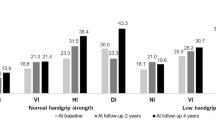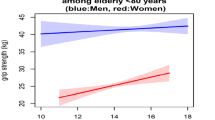Abstract
Proprioception is essential to several conscious and unconscious sensations and automatic control of movement in daily life activities. Iron deficiency anemia (IDA) may alter proprioception as it could induce fatigue, and affect neural processes such as myelination, and neurotransmitters synthesis and degradation. This study aimed to explore the effect of IDA on proprioception in adult women. Thirty adult women with IDA and 30 controls participated in this study. The weight discrimination test was performed to assess proprioceptive acuity. Attentional capacity and fatigue were evaluated, too. Women with IDA had a significantly (P < 0.001) lower ability to discriminate weights compared to controls in the two difficult increments, and for the second easy weight (P < 0.01). For the heaviest weight, no significant difference was found. Attentional capacity and fatigue values were significantly (P < 0.001) higher in patients with IDA compared to controls. Moreover, moderate positive correlations between the representative proprioceptive acuity values and Hb (r = 0.68) and ferritin (r = 0.69) concentrations were found. Moderate negative correlations were found between the proprioceptive acuity values and general (r = − 0.52), physical (r = − 0.65) and mental (r = − 0.46) fatigue scores, and attentional capacity (r = − 0.52). Women with IDA had impaired proprioception compared to their healthy peers. This impairment may be related to neurological deficits due to the disruption of iron bioavailability in IDA. In addition, fatigue resulting from IDA due to the poor muscle oxygenation could also explain the proprioceptive acuity decrease in women suffering from IDA.


Similar content being viewed by others
Data Availability
Anonymized data of all participants are stored locally and any raw data can be made available upon reasonable request.
References
WHO (2015) The global prevalence of anaemia in 2011. World Health Organization; Geneva, Switzerland
Kassebaum NJ et al (2014) A systematic analysis of global anemia burden from 1990 to 2010. Blood 123(5):615–624
Coad J, Pedley K (2014) Iron deficiency and iron deficiency anemia in women. Scand J Clin Lab Invest 74(sup244):82–89
Camaschella C (2015) Iron-deficiency anemia. N Engl J Med 372(19):1832–1843
Hentze MW et al (2010) Two to tango: regulation of Mammalian iron metabolism. Cell 142(1):24–38
Cheli VT et al (2020) Iron metabolism in oligodendrocytes and astrocytes, implications for myelination and remyelination. ASN Neuro 12:1759091420962681
Demetri GD (2001) Anaemia and its functional consequences in cancer patients: current challenges in management and prospects for improving therapy. Br J Cancer 84(s1):31–37
Petranovic D et al (2008) Iron deficiency anaemia influences cognitive functions. Med Hypotheses 70(1):70–72
Abdelhaleim AF, Amer AY, Abdo Soliman JS (2019) Association of zinc deficiency with iron deficiency anemia and its symptoms: results from a case-control study. Cureus 11(1):e3811
Penninx BW et al (2004) Anemia is associated with disability and decreased physical performance and muscle strength in the elderly. J Am Geriatr Soc 52(5):719–724
Taylor JL, Butler JE, Gandevia SC (2000) Changes in muscle afferents, motoneurons and motor drive during muscle fatigue. Eur J Appl Physiol 83(2–3):106–115
Allen TJ, Proske U (2006) Effect of muscle fatigue on the sense of limb position and movement. Exp Brain Res 170(1):30–38
Voight ML et al (1996) The effects of muscle fatigue on and the relationship of arm dominance to shoulder proprioception. J Orthop Sports Phys Ther 23(6):348–352
Henry M, Baudry S (2019) Age-related changes in leg proprioception: implications for postural control. J Neurophysiol 122(2):525–538
Reddy RS et al (2012) Correlation between lumbar extensor muscle endurance and lumbar proprioception. Int J Health Sci Res 2(1):20–26
Harrabi MA et al (2021) Iron deficiency anemia induces postural control disorders in young women. J Trace Elem Med Biol 68:126868
Ribeiro F, Oliveira J (2007) Aging effects on joint proprioception: the role of physical activity in proprioception preservation. Eur Rev Aging Phys Act 4(2):71–76
Riemann BL, Lephart SM (2002) The sensorimotor system, part I: the physiologic basis of functional joint stability. J Athl Train 37(1):71–79
Grob K et al (2002) Lack of correlation between different measurements of proprioception in the knee. J Bone Joint Surg British 84(4):614–618
Sohn J, Kim S (2015) Falls study: proprioception, postural stability, and slips. Biomed Mater Eng 26(Suppl 1):S693-703
Tremblay F et al (2001) Influence of local cooling on proprioceptive acuity in the quadriceps muscle. J Athl Train 36(2):119–123
Johnson KO (1980) Sensory discrimination: decision process. J Neurophysiol 43(6):1771–1792
Gentile S et al (2003) Validation of the French ‘multidimensional fatigue inventory’(MFI 20). Eur J Cancer Care 12(1):58–64
Jansen A et al (2003) Quality of life measurement in patients with transfusion-dependent myelodysplastic syndromes. Br J Haematol 121(2):270–274
Cohen J (1988) Statistical power analysis for the behavioral sciences, 2nd edn. Á/L., Erbaum Press, Hillsdale, NJ, USA
Schober P, Boer C, Schwarte LA (2018) Correlation coefficients: appropriate use and interpretation. Anesth Analg 126(5):1763–1768
Skinner H et al (1986) Effect of fatigue on joint position sense of the knee. J Orthop Res 4(1):112–118
Motonishi S, Tanaka K, Ozawa T (2018) Iron deficiency associates with deterioration in several symptoms independently from hemoglobin level among chronic hemodialysis patients. PLoS One 13(8):e0201662
Boyas S, Guével A (2011) Neuromuscular fatigue in healthy muscle: underlying factors and adaptation mechanisms. Ann Phys Rehabil Med 54(2):88–108
Fitts R (2006) The muscular system: fatigue processes. ACSM's Advanced Exercise Physiology, edited by Tipton CM, Baltimore, MD: Williams & Wilkins
Proske U, Gandevia SC (2012) The proprioceptive senses: their roles in signaling body shape, body position and movement, and muscle force. Physiol Rev 92(4):1651–1697
Enoka RM et al (2011) Unraveling the neurophysiology of muscle fatigue. J Electromyogr Kinesiol 21(2):208–219
Lephart SM et al (1997) The role of proprioception in the management and rehabilitation of athletic injuries. Am J Sports Med 25(1):130–137
Munoz P, Humeres A (2012) Iron deficiency on neuronal function. Biometals 25(4):825–835
Carlson ES et al (2010) Hippocampus specific iron deficiency alters competition and cooperation between developing memory systems. J Neurodev Disord 2(3):133–143
Ward KL et al (2007) Gestational and lactational iron deficiency alters the developing striatal metabolome and associated behaviors in young rats. J Nutr 137(4):1043–1049
Muñoz P et al (2011) Iron mediates N-methyl-D-aspartate receptor-dependent stimulation of calcium-induced pathways and hippocampal synaptic plasticity. J Biol Chem 286(15):13382–13392
Beard JL, Connor JR (2003) Iron status and neural functioning. Annu Rev Nutr 23:41–58
Author information
Authors and Affiliations
Contributions
MAH, SS, FA, and MT conceived and designed the experiments. MAH and TF drafted the manuscript. MAH, TF, FC, and RA performed the experiments and analyzed the data. RA, IM, and CK recruited patients and collected the blood samples. All authors commented on previous versions of the manuscript. All authors read and approved the final manuscript.
Corresponding author
Ethics declarations
Ethics Approval
This study was performed in accordance with the Declaration of Helsinki. Approval was granted by the “Protection Persons Committee for South,” approval number CPP SUD N° 0213/2020. All participants included in the study provided written informed consent.
Competing Interests
The authors declare no competing interests.
Additional information
Publisher's Note
Springer Nature remains neutral with regard to jurisdictional claims in published maps and institutional affiliations.
Rights and permissions
Springer Nature or its licensor (e.g. a society or other partner) holds exclusive rights to this article under a publishing agreement with the author(s) or other rightsholder(s); author self-archiving of the accepted manuscript version of this article is solely governed by the terms of such publishing agreement and applicable law.
About this article
Cite this article
Harrabi, M.A., Fendri, T., turki, M. et al. Iron Deficiency Anemia Is Associated with Proprioceptive Deficit in Adult Women: a Cross-Sectional Case–Control Study. Biol Trace Elem Res 201, 5162–5168 (2023). https://doi.org/10.1007/s12011-023-03603-5
Received:
Accepted:
Published:
Issue Date:
DOI: https://doi.org/10.1007/s12011-023-03603-5




